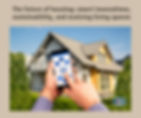THE FUTURE OF HOUSING: SMART INNOVATIONS, SUSTAINABILITY, AND EVOLVING LIVING SPACES
- mh0016
- Feb 2
- 2 min read

Contemporary residences extend beyond mere protection, reflecting personal identity, communal principles, and innovative practices. Incorporating smart technology and sustainable design, these homes emphasize efficiency and flexibility. In this article, we will examine the significant trends influencing the future of housing. To get professional help, get in touch with top architecture firms in CT.
HISTORICAL CONTEXT: THE EVOLUTION OF HOUSING
The evolution of construction has been remarkable, transitioning from colonial residences to contemporary smart homes. Industrialization drove urban expansion, which was later followed by suburban development. In the present day, the focus on sustainability and technological advancements is driving innovation in housing.
SUSTAINABILITY: DESIGNING ECO-FRIENDLY HOUSES
Contemporary residential architecture emphasizes sustainability through the integration of energy-efficient technologies, environmentally friendly materials, and water-saving practices. Homes of the future are expected to incorporate solar and wind energy, intelligent automation systems, high-efficiency appliances, and superior insulation to enhance both comfort and energy performance. The use of materials such as biocomposites and cross-laminated timber (CLT) will contribute to minimizing environmental effects and fostering sustainable building practices.
TECHNOLOGY INTEGRATION: THE FUTURE OF SMART HOMES
The future of residential living will be significantly influenced by advanced technologies, leading to homes that are increasingly intelligent, interconnected, and energy-efficient. Integrated systems will facilitate the automation of lighting, heating, security, and appliances, thereby enhancing both comfort and sustainability. Smart thermostats, security systems, and voice-activated assistants will customize the living experience for residents. In conjunction with artificial intelligence and the Internet of Things, these advancements will optimize energy efficiency and enable predictive maintenance, ultimately lowering costs and minimizing environmental impact. Consequently, homes will be designed to meet the specific needs of their inhabitants.
MULTIGENERATIONAL LIVING: ACCOMMODATING EXTENDED FAMILIES
Increasing living expenses have prompted a surge in multigenerational living arrangements, providing viable solutions to housing difficulties faced by both younger and older demographics. Such residences typically incorporate independent living areas, user-friendly designs, communal facilities, and versatile layouts. Various forms of multigenerational housing encompass vertical family dwellings, separate wings designated for different family units, stacked family homes situated on compact lots, and extended family residences featuring additional spaces. These architectural designs facilitate flexible utilization of space to meet the varied requirements of families.
URBAN MICRO-HOUSING: MAXIMIZING SMALL SPACES
As urban populations continue to increase, micro-housing plays a vital role in offering affordable accommodation in densely populated regions. These small residences optimize space through innovative designs, multifunctional furnishings, and communal living areas. Vertical space is utilized efficiently with elevated beds and wall-mounted storage solutions. Thoughtful lighting and the use of mirrors enhance the sense of space, while light, neutral color palettes contribute to a bright and airy atmosphere within the interiors.
CONCLUSION
Embracing the above advancements will enable us to establish a future characterized by efficient and sustainable homes for everyone, yielding a multitude of advantages. To discover more about advancements in new home construction, reach out to a local home construction company in Milford.




